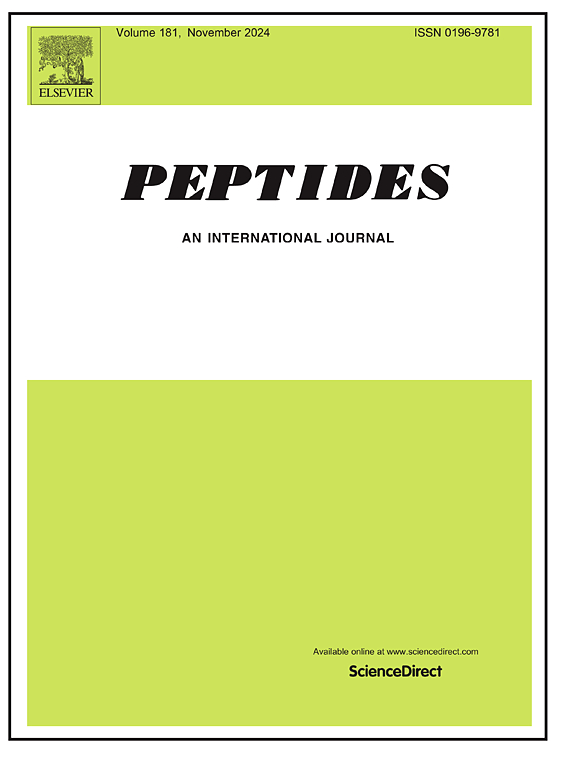Effect of central UAG on metabolic associated fatty liver disease: A possible mechanism involving in GLP-1 neural pathway
IF 2.9
4区 医学
Q3 BIOCHEMISTRY & MOLECULAR BIOLOGY
引用次数: 0
Abstract
Objective
The study aimed to investigate the possible effect of central unacylated ghrelin (UAG) on metabolic associated fatty liver disease (MAFLD) and its underlying mechanism.
Methods
A high fat diet (HFD) was fed to rat to construct MAFLD model. UAG was administered via intra-cerebroventricular injection (ICV) and its effect on MAFLD was observed. Glucagon-like peptide-1 (GLP-1) neural pathway was observed via FluoroGold (FG) retrograde tracking combined with immunofluorescence. To assess the involvement of the GLP-1 pathway, GLP-1 receptor (GLP-1R) inhibitor Exendin (9−39) was injected prior to ICV of UAG.
Results
ICV administration of UAG significantly reduced lipid accumulation in liver and liver injury in MAFLD rats which was partially attenuated by Exendin(9−39). Central UAG upregulated and activated GLP-1 neurons in nucleus tractus solitarii (NTS), and increased GLP-1 projections from NTS to paraventricular hypothalamic nucleus (PVN) and ventral tegmental area (VTA), respectively. Consequently, GLP-1R in PVN and VTA was activated, resulting in decreased food intake and reward behavior, as well as increased hepatic insulin sensitivity via activation of IRS-1/PI3K/Akt signaling pathway. These changes downregulated key lipogenic enzymes, including fatty acid synthase (FAS), acetyl-CoA Carboxylase (ACC) and stearoyl-CoAdesaturase-1 (SCD-1), thereby alleviating MAFLD.
Conclusion
These findings suggest that central UAG might alleviate MAFLD by modulating GLP-1 neuronal pathway from NTS to PVN and VTA. Further studies are needed to identify the specific receptor for UAG and its potential interaction with GLP-1 or GLP-1R, which could provide direct evidence for the role of central UAG in regulating food intake and lipid metabolism in MAFLD.
中枢UAG对代谢性脂肪性肝病的影响:涉及GLP-1神经通路的可能机制
目的:探讨中枢unacylated ghrelin (UAG)对代谢性脂肪性肝病(MAFLD)的可能作用及其机制。方法:采用高脂饲料(HFD)建立mald模型。通过脑室注射(ICV)给药,观察UAG对MAFLD的影响。采用FluoroGold (FG)逆行跟踪联合免疫荧光法观察胰高血糖素样肽-1 (GLP-1)神经通路。为了评估GLP-1通路的参与,在UAG的ICV之前注射GLP-1受体(GLP-1R)抑制剂Exendin(9-39)。结果:ICV给药UAG可显著降低mfld大鼠肝脏脂质积累和肝损伤,Exendin可部分减弱这种作用(9-39)。中央UAG上调和激活孤束核(NTS)的GLP-1神经元,增加GLP-1从NTS到室旁下丘脑核(PVN)和腹侧被盖区(VTA)的投射。因此,PVN和VTA中的GLP-1R被激活,导致食物摄入和奖励行为减少,并通过激活IRS-1/PI3K/Akt信号通路增加肝脏胰岛素敏感性。这些变化下调了关键的脂肪生成酶,包括脂肪酸合成酶(FAS)、乙酰辅酶a羧化酶(ACC)和硬脂酰辅酶饱和酶-1 (SCD-1),从而减轻了MAFLD。结论:中枢性UAG可能通过调节GLP-1神经元从NTS到PVN和VTA的通路来缓解mald。UAG的特异性受体及其与GLP-1或GLP-1R的潜在相互作用有待进一步研究,这可能为中枢UAG在MAFLD中调节食物摄入和脂质代谢中的作用提供直接证据。
本文章由计算机程序翻译,如有差异,请以英文原文为准。
求助全文
约1分钟内获得全文
求助全文
来源期刊

Peptides
医学-生化与分子生物学
CiteScore
6.40
自引率
6.70%
发文量
130
审稿时长
28 days
期刊介绍:
Peptides is an international journal presenting original contributions on the biochemistry, physiology and pharmacology of biological active peptides, as well as their functions that relate to gastroenterology, endocrinology, and behavioral effects.
Peptides emphasizes all aspects of high profile peptide research in mammals and non-mammalian vertebrates. Special consideration can be given to plants and invertebrates. Submission of articles with clinical relevance is particularly encouraged.
 求助内容:
求助内容: 应助结果提醒方式:
应助结果提醒方式:


